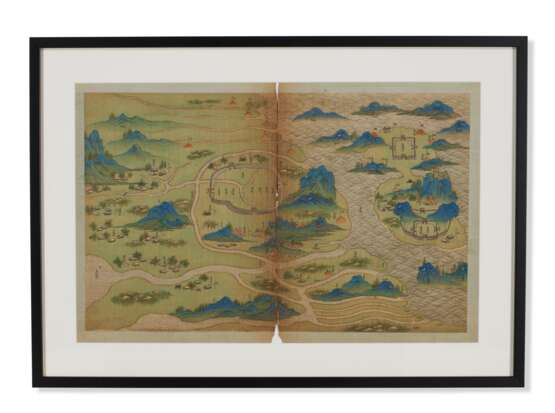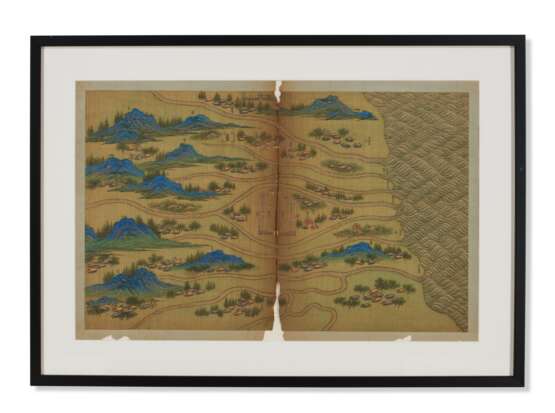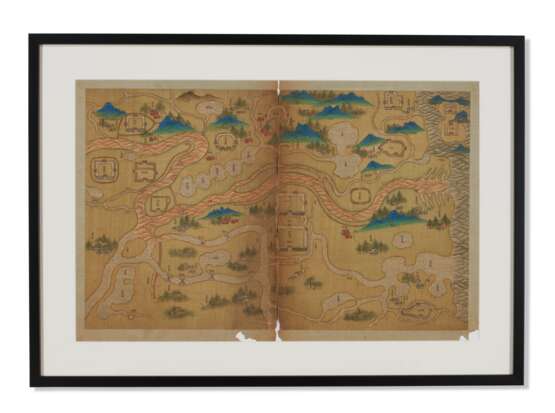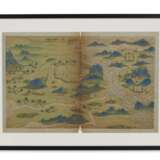ID 627560
Lot 70 | Huai’an Prefecture
Valeur estimée
$ 12 000 – 18 000
Handsome and very rare Ming Dynasty Maps on silk, of Huai'an prefecture and its precincts. These maps are from a 50-leaf atlas Lianghuai Diqu Fuxian Tuce (Map Collection of Administrative Districts along the Huai River), compiled during the Wanli period (1573-1620) of the Ming dynasty (Chan). Different from the type of map created by the method of jili huafang (counting in Chinese measurements and drawn in grids), these three maps are painstakingly painted in evocative traditional Chinese blue-and-green landscape style, portraying important constructions of the area, such as the Office of the Huai’an Prefecture, the government-run prefectural-level Confucian school, the Battalions of the West Sea and the East Sea, etc. This type of landscape-style map prevailed in the Ming dynasty, when painters often acted as cartographers (Lin). These three maps were very likely painted at local government offices, not made for publication but kept as government materials. The album which these three pieces are from is considered one of the earliest extant landscape-style atlas albums produced by governmental offices (Osawa). In the present lot, the piece with the Office of Huai’an Prefecture depicted in the center also delineates the Yellow River crossing the land from left to right to meet the sea. This depiction refers to the phenomenon “Yellow River snatching the waterway of the Huai River,” happening from the 12th century to 1855, when the Yellow River finally returned to its natural course and entered the sea from Shandong Province (Chan). For a comparable copy of the Map of Huai’an Prefecture, see Wanru Cao, Zhongguo Gudai Ditu Ji: Mingdai [Collection of Chinese Ancient Maps: Ming Dynasty] (1995), pl. 25. References: Libby Lai-Pik Chan, East Meets West - Maritime Silk Routes in the 13th-18th Centuries, 2016; Meicun Lin, “A Study on the Court Cartographers of the Ming Empire,” Journal of Asian History, Vol. 49, No. 1-2, pp. 187-228; Akihiro Osawa, “Landscape-style Maps in Traditional Chinese Local Government” (2019); Akihiro Osawa, “Mingmo Ditu yu Gongdu—Diyuxing Zhengshu de Chuxian (Late-Ming Maps and Official Documentations—the Appearance of Regional Literature on Administration)” (2007).
Three manuscript maps of Huai’an Prefecture and its surrounding districts, ink and colors on silk, with silk borders, each map composed of 2 separate sheets; originally in the form of album leaves, now within modern black frames, 2 pieces approx. 400 x 590 mm (image), 1 piece approx. 395 x 585mm (image). The maps incorporate blue-and-green hills and islands, lakes and seas with different types of wave patterns, canals, bridges, village houses, official constructions encompassed by walls and watch towers, pagodas, temples, flood mounds and trees all meticulously delineated, annotated with Chinese names. Very good condition with the luster of pigments well preserved on the smooth silk (some toning and light chipping on the inside edges or the individual map sheets and a few additional border chips at top and bottom). Matted and framed (unexamined outside of frames).
Exhibited: "The World on Paper: From Square to Sphericity," Hong Kong Maritime Museum, December 2019 to March 2020.
Please note that this lot is subject to an import tariff. If the buyer instructs Christie’s to arrange shipping of the lot to a foreign address, the buyer will not be required to pay the import tariff. If the buyer instructs Christie’s to arrange shipping of the lot to a domestic address, if the buyer collects the property in person, or if the buyer arranges their own shipping (whether domestically or internationally), the buyer will be required to pay the import tariff. Please contact Post Sale Services on +1 212 636 2650 prior to bidding for more information.
| Artiste: | William Shakespeare (1564 - 1616) |
|---|---|
| Technique appliquée: | Crayon |
| Artiste: | William Shakespeare (1564 - 1616) |
|---|---|
| Technique appliquée: | Crayon |
| Adresse de l'enchère |
CHRISTIE'S 8 King Street, St. James's SW1Y 6QT London Royaume-Uni | |
|---|---|---|
| Aperçu |
| |
| Téléphone | +44 (0)20 7839 9060 | |
| Commission | see on Website | |
| Conditions d'utilisation | Conditions d'utilisation |














